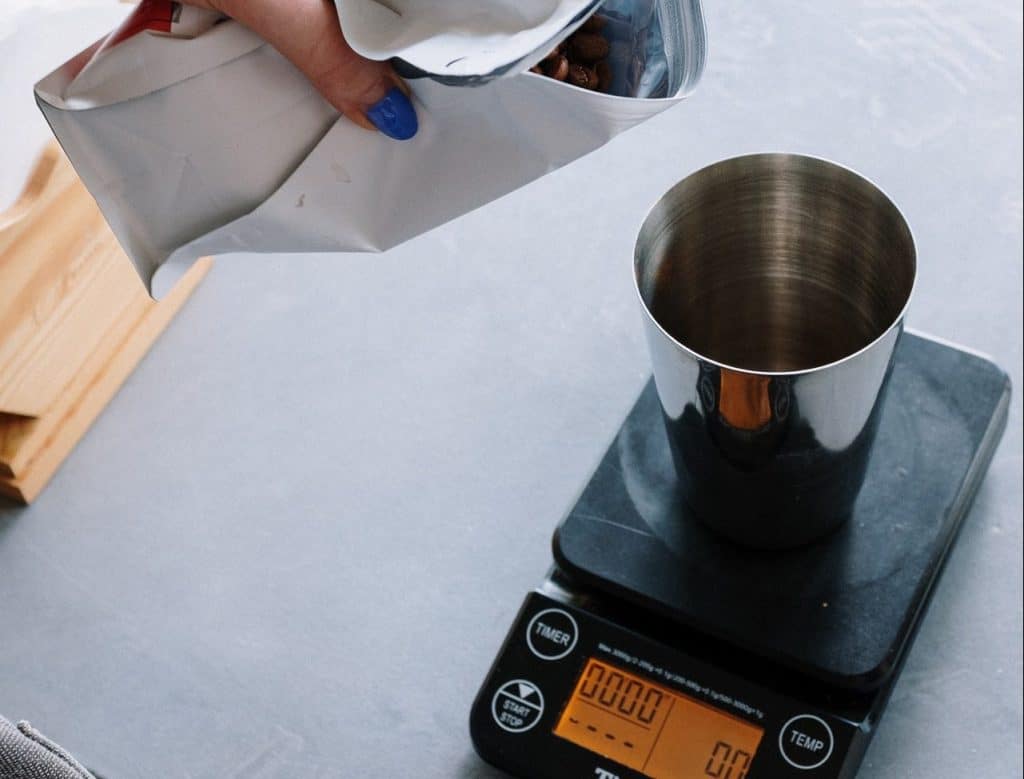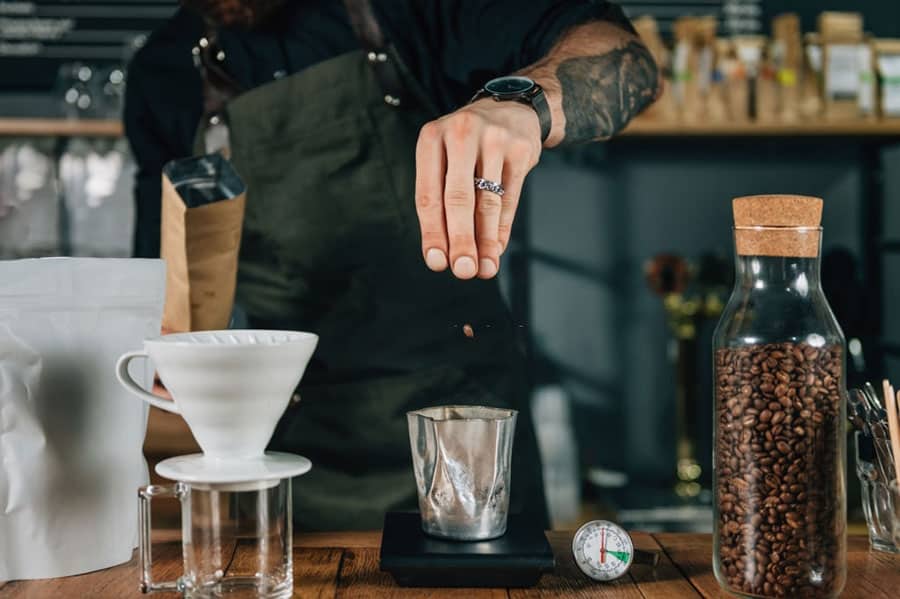How to Measure Coffee — Brewing Ratios for the Perfect Cup

Nothing beats a well-brewed cup of coffee. I even doubt that most of us would triumph over the demands of work-life if it wasn’t for that good, strong cuppa in the morning. Unfortunately, though, if you don’t know how to measure coffee correctly, you will end up with a flat-tasting beverage at best.
Your entire day could actually be ruined because of that weak coffee, and I’m sure you do not want that to happen. But as you probably know, brewing great coffee is easier said than done.
So, where do you start when it comes to correct measurement ratios? Well, that’s what this guide is all about. I’ll cover everything from the importance of measuring your coffee to the different measurement methods.
Let’s get started, shall we?
What’s the Importance of Correct Coffee Measurements?
You can have the best coffee beans, but your drink will taste like sludge if you don’t mix it right. Without precise measurements, your cuppa will either be over-extracted or under-extracted. This means it will either have a sour taste or will lack the necessary caffeine kick to keep you going.
What’s more, learning how to properly measure your coffee reduces waste. Think about it: With the proper measurement, you use only the amount of coffee you need.
The end result is a consistent brew that not only tastes great but has the kick you need to keep going all day long.
Measuring Coffee without a Scale
Any serious coffee lover will tell you that you can’t do coffee correctly without a scale. This is generally true, but it doesn’t mean you should give up on brewing just because you lack one. You can still make great espresso without a scale—the trick is to use the right approach.
Here’s how you go about it:
Step 1: You are going to need a tablespoon scoop and a measuring cup. That’s it.
Step 2: The next step is getting your coffee-to-water ratio just right. Locking down this ratio will help you brew great coffee regardless of the quantity.
The Specialty Coffee Association of America recommends a brew ratio of 1:18. It’s actually the golden cup standard.

Allow me to explain.
With the 1:18 ratio, for every 55 grams of coffee, you are going to need 1,000 ml of water (1,000/55 = 18). In America, a cup is 8 ounces, and 1 ounce is roughly 30 ml. So for 1,000 ml, you are looking at 33 ounces, which is approximately 4 cups of water for every gram of coffee (about 0.03 ounces).
Keep in mind that you can push the brew ratio from 1:18 to1: 22. Put differently, that’s 55 g/L +/- 10%.
So, why is this mixing ratio preferred?
Well, using this ratio ensures that your coffee is in equilibrium, where the bitter notes and acids are in perfect balance. As a result, you’re able to taste the sweet sugars in your brew.
If you add too much water per gram of coffee, your coffee will most definitely turn out weak and bitter. Using less water, on the other hand, has the opposite effect. The result will be concentrated coffee with a sour and unpalatable taste.
My advice? When measuring without a scale, stick to the golden ratio for the best possible result.
Implementing the Golden Ratio
Now that you understand the basics of the golden ratio, the next thing you will want to know is how to implement it, especially since you have no measuring scale.
The good news is that knowing how many tablespoons of coffee per cup to use isn’t that hard. A level tablespoon of coffee is around 6 grams ( approximately 0.2 ounces).
When it comes to measuring your water, direct translation works in your favor. In short, 1 millimeter of water directly translates to 1 gram of water.
Here’s a real-world example to help you out:
For a 12 oz mug of coffee, you’ll do the following:
- Twelve ounces is roughly 360 milliliters. Use your measuring cup to pour this amount into your pot.
- Since you are using the 1:18 golden ratio, divide the water weight by 18, which will give you the amount of coffee you need. 360/15 is roughly 24 grams.
- Remember, a level tablespoon holds around 6 grams of coffee. How many tablespoons in a cup of coffee will you need then? In this case, only four.
There you have it. Measuring your coffee without a scale is this simple.
Since the golden ratio is fixed, you can get creative and figure out different scenarios, for example, finding out how much water you need if you have a fixed amount of coffee left.
The best part is that the math is simple and straightforward. However, you shouldn’t entirely depend on this approach. Here’s why.
Why You Shouldn’t Depend on Volume Measuring
Volume measuring might be great when you are just starting out. However, you should only use it as a temporary system. Even though the method is effective in its own right, it has some glaring problems.
First of all, coffee beans vary in size depending on where they come from. This means that it’s not accurate to assume that a level tablespoon of coffee beans will always contain 6 grams of coffee. If someone asked you how many tablespoons of coffee per cup of water they should use, always explain this aspect to them before suggesting a figure.
To further add to the problem, the density of coffee beans varies as well. Depending on the type of bean you have, a tablespoon might be anything from 5 grams to 8 grams. The bottom line is that you will have no way of knowing for sure without a scale.
As you can imagine, such variables mean that brewing consistent coffee using volume measuring is very difficult.
Honestly, you will want to bite the bullet and invest in a scale at some point. It’s the only way you will get the best out of your coffee every time.
How to Measure Coffee Using a Digital Scale
If you want to brew consistent coffee, using a digital scale is your best bet. Unlike eyeballing your values using the volume measurement method, a digital scale offers you accurate and consistent results. In all honesty, you will find measuring with a scale much easier compared to measuring using a tablespoon.
Here’s how you go about it:
Step 1: Once you have determined your coffee-to-water ratio (stick to the golden ratio), your next step is measuring your ingredients.
Step 2: Place an empty container on the scale, but make sure you reset the scale to zero before you add your coffee. This ensures that the container’s weight is not included in your final measurements.
Step 3: Scoop coffee into the container until you reach the preferred weight. You should also do the same for the water. Just place your coffee pot on the scale, reset it and add the correct amount of water. Since you will lose some water to evaporation, add slightly more to compensate for this.
The best part about using a scale is that you can easily adjust your measurements to increase or reduce the intensity of your brew. Keep in mind that you should only adjust the amount of coffee and not the water volume. This way, only the taste of your coffee is affected and not the amount.

FAQs
Do you really need a measuring scale?
Yes, you do. While it is possible to make good coffee by using estimation, there is a high chance for error. Making exact measurements is not humanly possible.
There is also the fact that coffee beans have different densities and sizes depending on where they came from. Without a scale, you will have no way of confirming if your coffee measurements are correct.
Should you buy whole beans or ground coffee?
Ground coffee is great if you don’t have a grinder. However, coffee beans are perfect if you want your coffee to remain fresh for a long period of time.
As you can guess, ground coffee is easy to measure using the two methods we have looked at, but what about coffee beans? Well, you will be glad to know that the weight of your grounds remains the same even after the grinding process. Just make sure that not too much is left stuck in your grinder.
Measuring coffee grounds using the estimation method can be a bit tricky; however, since a level tablespoonful of coffee beans is roughly 6 grams, you can easily measure what you need without a scale.
Does the size of my grounds affect my coffee?
Yes, it does. However, this only applies if you are grinding your own coffee beans. Coarse grounds will produce weaker coffee compared to medium and fine grounds. Of course, the result won’t be that noticeable. Adjusting your water-to-coffee ratio gives you more control in deciding how strong or weak your coffee will be.
Final Thoughts on Coffee Measurements
Well, that’s all you need to know about how to measure and brew a great strong cuppa. As you have probably noticed, the process becomes simple once you understand the basics. However, you will need to pay more attention when you are doing this without scale. The most important thing is to ensure you get the measurements for water and coffee right. That said, the best part is you can experiment to create coffee blends that match your own unique taste.
Owen is a writer and editor at Caffe Streets who considers himself a coffee fanatic. He spends his time researching and testing different coffee beans and brewing methods and sharing what he learns with others.





